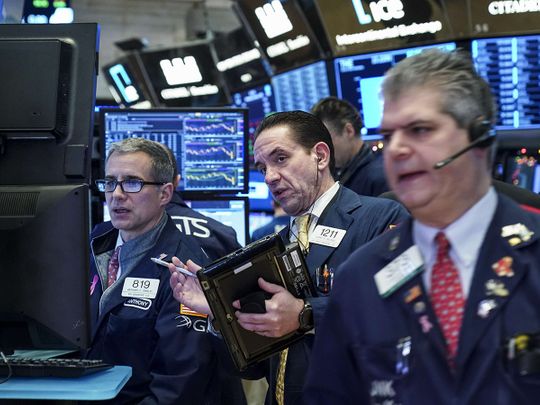
Dubai: With global stocks now rallying, does this mean that investors now see a bright future for markets beyond the COVID-19 crisis? Is the worst over and will this turnaround last?
These are the key questions in the minds of most market spectators – and while some top analysts agree, some are still on the fence about it.
Global stocks, led by US’ Wall Street, rose sharply this week, in contrast to prior weeks’ losses. Now most markets are comfortably above their March lows. (Stocks plummeted last month with the pandemic escalating rapidly.)
All three US benchmarks rose by 11-12 per cent last week, with the S&P500 recording its best performance since 1974. Major indices in Europe, Asia and the Middle East too rose for the first time in weeks.
Have markets bottomed?
“Markets have been encouraged by corona curves flattening in Europe, exits from lockdowns in China, and talk of economic reopening globally,” Stephen Innes, chief global markets strategist at AxiCorp, wrote in a note.
“The level optimism has caught virtually everyone by surprise, none more so than big macro investors that have been forced to chase this market higher.”
Stock prices are always based on what the world will look like in the future, not the present. In the global financial crisis, stock prices bottomed out in March 2009. The economy did not begin expanding again until July, and the unemployment rate would not peak until October.
So, markets may have bottomed out, meaning that it is not expected to fall further from here – or so, that is what the latest share moves suggest. But again, not all analysts want to give into what they consider is a false sense of optimism.
Some agree, some don’t
“Some will say that it is merely overly gloomy expectations that are triggering a short-covering rally,” Innes added. “At the same time, the real pessimists will argue that unprecedented central bank activity will not be enough to bolster the markets without credible exit strategies from epic-scale social distancing.”
While Morgan Stanley and JP Morgan are among the major fund houses that think that stocks have bottomed, Goldman Sachs chief equity strategist David Kostin is skeptical about the recent rally.
“I would remind you that that in 2008 in the fourth quarter there were many different rallies – I call them ‘bear market rallies’, some of which were almost 20 per cent a couple of times, but the market did not bottom till March 2009,” Kostin noted.
BNY Mellon Investment and Citi are among the brokerages that isn’t confident about the rebound and see more pain ahead for investors, with an analyst among them also seeing a “double bottom” for markets.
While the current market pricing suggests that investors are counting on a speedy rebound, let’s not forget that this is all conditional on the fact that the pandemic does not go on much longer than expected and it really is just a three- to six-month event, and not more.
Confidence has returned, for now
But the consensus remains that confidence has returned to markets on signs of reduction in the number of daily coronavirus cases in some COVID-19 hotspots.
Sentiments are changing from ultra-pessimistic to mildly pessimistic and that is what is driving markets higher. Trillions of dollars of economic stimulus packages in the US, Japan and other economies that have also helped boost confidence to a large extent.
But given that currently there isn’t yet any consistant material evidence that the pandemic is stalling in global hotspots, it only seems like a 50:50 bet that the virus outbreak has seen an end, and in turn chances for further market volatility. So, it’s still a wait-and-watch scenario.
It has also been widely forecasted that once the lockdown is lifted, markets will start taking note of the ground reality and react accordingly as the aftereffects of the lockdown will start emerging.
This may help the bears to take charge once again for the possible second round of fall in the market, analysts note.
Till then, the unanimous view is that this would be the market trend, and as for regional stock markets, trend watchers continue to see them emulating the global indices.








